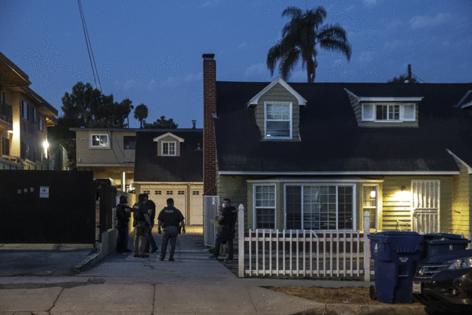Commentary: Warrantless home abductions by ICE are a recipe for Wild West shootouts
Published in Op Eds
Since the beginning of President Donald Trump’s second administration, U.S. Immigration and Customs Enforcement has significantly increased its enforcement actions nationwide. This shift has seen the use of more aggressive and combative tactics by ICE, including entering dwellings by force and without judicial warrants— as instructed by the Trump administration. In a March memorandum, U.S. Attorney General Pam Bondi, relying on the obscure Alien Enemies Act of 1798, asserted that federal agents can enter homes without a judicial warrant.
First: This is preposterous. The Trump administration cannot bypass basic constitutional protections merely by issuing a memorandum.
Second: It’s also reckless. This tactic puts federal agents, residents and bystanders at risk for Wild West-style shootouts, especially because state laws protect residents from prosecution when they use deadly force to defend their homes. To avoid needless bloodshed, these warrantless raids must end now.
ICE often conducts operations without judicial warrants. Immigration enforcement is primarily a civil rather than a criminal matter. For much of its enforcement work, ICE does not need a judicial warrant. The laws that govern ICE give its agents authority to question and briefly detain individuals believed to be in the country illegally. These laws also give ICE the right to arrest someone if the agent believes that person is violating immigration law and is likely to escape before an arrest warrant can be obtained.
Immigration agents have leeway to enter public portions of public buildings without a court order, but not private areas or homes. ICE cannot ignore longstanding judicial warrant requirements when agents want to enter a dwelling.
The requirement for a judicial warrant stems from the 4th Amendment, which protects people — citizens and noncitizens alike — from “unreasonable searches and seizures.” Except in a few limited situations, such as exigent circumstances (an emergency) or where evidence of a crime is in plain view, federal agents need a warrant signed by a judge before they can enter a home without the occupant’s permission. And, federal agents must generally knock and announce their presence and purpose before entering a home, even with a valid warrant. (The rise of “no-knock warrants” in recent decades has predictably led to confusion, tragedy and bloodshed, just as ICE’s new tactics inevitably will.)
These constitutional restrictions apply to ICE. If agents enter a home without a warrant and without meeting one of the exceptions for a warrantless entry, they are entering illegally and are home intruders. This is the point at which state law kicks in.
State laws provide significant protection to people defending their homes from illegal intruders. Most states have a version of the “castle doctrine,” the legal principle that allows individuals to use force — including lethal force — to defend themselves and others against an intruder in their home without a duty to retreat. Under these laws, an unlawful and forcible entry into an occupied home is presumed to create an inherent risk of great bodily injury or death to the occupants, so the occupant is authorized to use deadly force.
While the specifics vary by state, the core concept is that a person’s home is their sanctuary, and they have the right to immediate self-defense against perceived threats within it. As the Maryland Court of Appeals noted, “There is … a generally accepted rule, which we think is correct, that a man faced with the danger of an attack upon his dwelling need not retreat from his home to escape the danger, but instead may stand his ground and, if necessary to repel the attack, may kill the attacker.”
Most states also allow residents to use deadly force against a home invader even in the absence of a threat of death or serious bodily injury to the home occupants. The right to use deadly force is not absolute and varies by state.
These state laws are not little-known or obscure; they are quite familiar among gun owners. Firearms training courses often teach students that state laws protect them from criminal liability if they shoot a home intruder. Gun advocacy groups not only advocate for these defense laws but also keep their members informed about their legal right to use deadly force to defend their homes.
While some states’ laws specifically exclude the use of deadly force by a resident against the police, these exclusions may matter little in the heat of the moment. An armed resident in mortal fear — and forced to make a split-second decision — will likely fire if confronted by unidentified, armed and possibly masked home invaders.
In light of ICE’s recent enforcement tactics and in the presence of these state home protection laws, a deadly shooting involving ICE agents is not only imaginable, it is likely. It will happen like this: ICE agents suddenly and forcibly enter a home without a warrant (possibly in plainclothes and masked). A fearful resident who owns a gun opens fire on the intruders. ICE agents then return fire. Agents, occupants and bystanders could be killed or wounded.
This deadly situation is made possible by one thing: ICE agents forcefully entering dwellings without a judicial warrant. We’ve already seen this during recent ICE raids in Chicago. A resident — and U.S. citizen — reported that ICE entered his apartment without a warrant and abducted him.
We need to be clear. We are neither challenging nor advocating the Trump administration’s prerogative to enforce the nation’s immigration laws. We also strongly oppose the use of violence against ICE agents. Those whose households are illegally invaded by ICE should seek relief from the courts, not through the barrel of a gun. We are, however, quite fearful that the current home-invasion tactic used by ICE will eventually provoke an armed and deadly response from a lawfully armed resident — a response that state law may allow.
State laws aren’t going to erase the right of residents to defend themselves in their homes. Gun owners aren’t going to set their weapons aside when masked and unidentified strangers break in and try to abduct them. There is only one way to quickly and effectively end the risks posed by these dangerous federal immigration enforcement tactics: End warrantless ICE raids now.
____
John Aloysius Cogan Jr. and Miguel F. P. de Figueiredo are law professors at the University of Connecticut.
©2025 Los Angeles Times. Visit at latimes.com. Distributed by Tribune Content Agency, LLC.
























































Comments